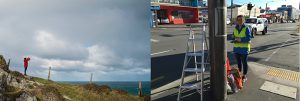Current position: Science Technician, NIWA (2014-present)
BSc(Hons): University of Otago (2010-2013)
Photo: Zoë at work (photos by Dave Allen and Mark Ma)
I spent one year as an honours student in the Brooker Bunch (2013). My honours research focused on the synthesis and characterisation of carbazole-based ligands, and some of their first-row transition metal complexes.
I enjoyed being part of Sally’s group. They were a friendly, fun and generous bunch, and I’m very grateful for the guidance and encouragement I received from everyone there, particularly the wonderful postdocs. Sally has an infectious enthusiasm for her science, plus a huge amount of expertise, and I really valued the conversations I had with her about my work (and life beyond).
I was in the Department of Chemistry for four years. It’s a lively department, with interesting research programmes, and a great social atmosphere: the $1 tearoom scones provided an especially good way to start each day, and Chem Club was a great way to end the week. The department has an active school outreach unit, and weekly seminars bring in a wide variety of scientists from across New Zealand and the world.
Dunedin is a small and vibrant city, with a big heart. It has a bustling centre, great cafés, beautiful buildings, a well-established music scene, and a real university town feel. Nature is everywhere in Dunedin. From campus, I used to love running down to Otago Harbour, or wandering up through the forest of Ross Creek, or cycling out to the sweeping surf beach at St Clair. Dunedin has so many great beaches, each with its own character: with albatrosses, sea lions, penguins, caves, enormous sand dunes, beautiful estuaries, sparkling clear waters or just an expansive sense of wilderness and the open ocean.
After finishing with Sally’s group I moved to Wellington, to work as a science technician at the National Institute of Water and Atmospheric Research (NIWA). I’m in the Atmospheric Chemistry and Physics group, which comprises around thirteen scientists and technicians. My role is quite varied, which I like, and involves a mixture of field, lab and office work.
A major focus area for us is atmospheric greenhouse gases – monitoring their concentrations over New Zealand, Antarctica and the Pacific, and using isotope methods, measurements of other related gas species and computer modelling to try an understand how and why atmospheric composition is changing over time.
For example, I’m part of the team that runs NIWA’s Baring Head Clean Air Monitoring Station, near Wellington. Baring Head hosts a number of important time-series including the longest continuous record of atmospheric carbon dioxide in the Southern Hemisphere (and the second longest globally), and the longest record anywhere of atmospheric radiocarbon (which began in the 1950s, early enough to capture the rise and fall of atmospheric 14C due to nuclear testing in the Pacific).
I work with a few different instrument and sampling systems, including infrared and laser-based optical instruments, gas chromatography, mass spectrometry, vacuum line set-ups (for extracting different compounds from air), a few specialist instruments (e.g. a count-based system for measuring atmospheric Rn-222), plus a range of meteorological gear (for gathering climate data). I spend quite a lot of time in the office too, e.g. planning fieldwork, checking and analysing data, and managing another remote monitoring site (near Rotorua).
In many ways, the work I do currently is quite different to the synthetic organic and inorganic chemistry I did in Sally’s group. Regardless, doing an honours project taught me some very valuable things. It gave me a significantly better understanding of how science research operates. It also taught me a lot about problem solving – including the wisdom of (a) only changing one variable at a time and (b) resisting the urge to continue to tinker after you’ve finally got something working!
I’m more than happy to answer any questions about studying chemistry at Otago, doing honours, working at NIWA, or generally being in the field of environmental science. Just get in touch via Sally.


